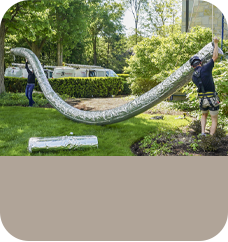Chimney Relining
The chimney is designed to allow you to enjoy the warmth of a fire in the comfort of your home – but there are a lot of system components that have to be properly cared for if your system is to maintain safety and efficiency levels.

We Specialize In Quality Chimney Relining Services
One of the most important components that must be properly installed and maintained is the chimney liner.
As you know, a great deal of heat, smoke, and byproducts are created every time you light up a fire in your fireplace – and it’s the chimney’s job to remove these things from the home. The chimney liner, which is the inner lining of the chimney flue, works to contain the high heat and byproducts of combustion, protecting the masonry, preventing heat transfer to nearby combustibles, and keeping smoke and carbon monoxide from entering the home’s air supply on the way out of the home.
What Is A Chimney Liner & Why Is It So Important?
Unfortunately, chimneys haven’t always been properly lined over the decades. Many historic chimneys were built without liners, which the National Bureau of Standards has categorized as “little less than criminal.” As the importance of chimney liners was realized, chimneys were most frequently lined with clay tiles or metal liners. Although both of these are quite durable and effective, there are a few things that detract from their safety and efficiency, making a relining necessary. Here are some of the most common reasons for chimney relining:
 Moisture & Freeze-Thaw Damage
Moisture & Freeze-Thaw Damage
If water has access to your chimney liner, the damage is inevitable. As temperatures rise and fall, moisture absorbed by your clay tile liner will freeze and thaw, contracting and expanding, causing the clay tiles to crack and crumble. If your liner is made of metal, water can corrode the liner, leaving it riddled with rust and holes.
Resize Flue
If your flue is improperly sized for your fireplace opening or the new appliance you’re having installed, a new chimney liner may be able to fix the problem by resizing your flue!
Change In Fuel Type
Not all liner types are safe for use with all fuel types. If you are switching fuel types, your existing liner may need to be replaced with a different material that is more equipped to handle your new fuel choice. (For example, an aluminum liner is not designed to handle the high heat of a wood fire.)








